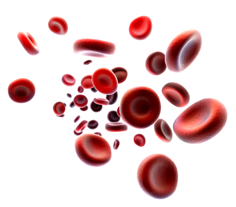Anaemia
 Overview
Overview
Humans need oxygen, which is inhaled with each breath, to nourish the tissues and organs that make up the body. The red blood cells carry oxygen molecules through the bloodstream with a little help from a substance known as hemoglobin. Anaemia is the condition that takes place when too few healthy red blood cells are present to transport the oxygen throughout the body.
People suffering from anaemia are unable to receive an optimal amount of oxygen carrying capacity in their bloodstreams.
A few of the symptoms include feeling tired, appearing pale, and having an elevated heartbeat and shortness of breath.
Causes
Several conditions can cause anaemia. They include damage to the existing red blood cells, loss of blood, or inadequate production of red blood cells in the person's bone marrow.
Types
There are eight basic types of anaemia. Below they are listed, along with brief explanations of each.
- Iron-Deficiency Anaemia - The most common type of anaemia, this occurs when the body does not have adequate iron to produce haemoglobin. Blood cells are re-cycled through the body as a sauce of iron, so blood loss (such as that from a heavy menstrual cycle or a bleeding ulcer) can cause this type of anaemia. Other causes include poor nutrition or pregnancy. When a woman is pregnant, iron is taken from her body to support the growing fetus.
- Vitamin-Deficiency Anaemia - Vitamin B12 and folate are necessary for the production of healthy red blood cells. When a person's diet is low in folic acid and vitamin B12, this type of anaemia may be caused. Also, if the individual's body is unable to absorb vitamin B12, a condition called pernicious anaemia can result, affecting the nervous system.
- Aplastic Anaemia - This is a serious condition resulting from bone marrow being unable to produce blood cells. Thought to be an autoimmune disease, in this condition the body mistakenly attacks healthy cells. Aplastic anaemia has been associated with radiation therapy, toxic chemicals, chemotherapy and certain medications.
- Haemolytic Anaemia - This occurs when red blood cells are destroyed faster than bone marrow can replace them. It is caused by a malfunctioning immune system that destroys healthy red blood cells, or by medications such as blood pressure medicine or antibiotics.
- Sickle-Cell Anaemia - This is an inherited condition that frequently is seen to occur in individuals of Arabic or African descent. It is often associated with painful crises and can be very serious. Abnormal haemoglobin causes the red blood cells to become crescent-shaped. The body quickly destroys these cells but they are unable to pass through the bloodstream, which can cause severe pain.
- Thalassaemia - Patients suffering from this condition have red blood cells which are incapable of surviving for extended periods to due to some type of abnormality. In more severe cases of this condition, iron is deposited in the vital organs and the skin.
- Glucose-6-Phosphate Dehydrogenase (GP6D) Deficiency - The enzyme known as G6PD protects red blood cells from premature damage. People who are born with insufficient levels of G6PD cannot sustain normal levels of red blood cells in their bodies. Some foods, such as fava beans, can cause the onset of an episode of haemolysis.
- Chronic Disease - Some chronic diseases tend to inhibit the product of healthy red blood cells. They include kidney disease and chronic infections. In the case of kidney failure, the body cannot produce enough red blood cells due to a decrease in erythropoietin, a hormone which is produce in the kidney that stimulates production of red blood cells in bone marrow.
Prevention
One of the best ways to help prevent iron and vitamin deficiency anaemia is to consume a well-balanced diet of foods which are rich in vitamin B12, folic acid and iron. These include beef, leafy green vegetables, nuts and fortified breakfast cereals.
Vitamin C increases the absorption of iron into the body, while calcium decreases absorption. Diseases such as Crohn's can make it difficult to absorb enough of the nutrients necessary for healthy red blood cells, even with adequate intake. Some forms of anaemia cannot be prevented.
Diagnosis
Blood tests can be used to confirm anaemia, but symptoms can include chest pains, dizziness, headaches, inability to concentrate, fatigue, shortness of breath and feeling cold in the arms and legs. If the case is mild, no symptoms may be noticed at all. A complete blood county will reveal levels of red blood cells and haemoglobin in the bloodstream.
Additional testing may be needed in order to pinpoint the cause of the anaemia.
Treatment
Some treatments can include:
- Change in diet.
- Discontinuation of medication causing the problem.
- Blood transfusions or bone marrow transplant.
- Taking supplements, including iron, bee pollen, B12, spirulina, folic acid, dandelion root, gentian, yellow dock, burdock root, comfrey root, ginseng, red raspberry and nettle leaves. For those who have difficulty absorbing B12, a combination of goldenseal, gentian and wormwood powder taken in capsule form helps to increase the level of hydrochloric acid. However, this concoction should only be taken for a couple of weeks at a time.
Avoid refined foods, salt and too much red meat. Caffeine and alcohol are typically detrimental to healthy blood and should be reduced or eliminated.
References
- Bratman, S. (1998). The Alternative Medicine Ratings Guide: an expert panel rates the best treatments for over 80 conditions. New York: Crown Publishing Group (1998)
- Brown, L. (1999). Alternative Medicine. London : Teach Yourself
- Duke, J. (2003). The Green Pharmacy: Herbal remedies for common diseases and conditions from the world's foremost authority on healing herbs. London : Rodale
- Gomez, J. (2002). Anemia in women : self-help and treatment. Alameda, CA : Hunter House.
- Servan-Schreiber, D.(2006). The Encyclopedia of New Medicine: Conventional & Alternative Medicine For All Ages. London : Rodale
Posted in Anemia
Ask a Question Or Join a Discussion


